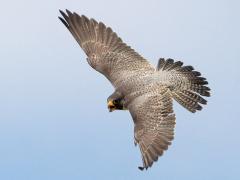Peregrine Falcon Project
We work closely with NJDEP Fish & Wildlife's Endangered and Nongame Species Program to help monitor the peregrine falcon population in New Jersey.
 Zoom+ A female peregrine falcon. Photo courtesy of Kim Steininger.
Zoom+ A female peregrine falcon. Photo courtesy of Kim Steininger.
New Jersey is home to more than 40 breeding pairs of Peregrine falcons (Falco peregrinus). We work closely with biologists with the Endangered and Nongame Species Program to help monitor the population. Each winter we conduct maintenance on nesting towers, to help reduce predation and use by other species. In spring and summer we monitor nest sites for activity, which include checking for onset of incubation, hatching and then return for banding of young.
Trail cams at select nests to monitor prey that is brought into them. These cameras can also aid in the identification of banded adults, along with traditional avian photography. Collecting re-sightings of auxiliary banded birds provides valuable information including age, site fidelity, and the turnover rate in the population. After we have successfully identified the breeding pair, we continually monitor each nest or eyrie until the young are old enough to band (approximately 3-4 weeks old).
In 2022, the peregrine falcon population remained unchanged with 43 total pairs occupying sites and 38 known to lay eggs. Successful pairs dropped slightly with 26 producing 61 young -- for a productivity rate of 1.61 (known) young per active nest and a success rate of 68%. The core of the population continues to nest on towers and buildings throughout the state.
Thanks to early reintroduction efforts, peregrine falcons are now a fairly common sight (if you know where to look - look up!). From the Palisades cliffs along the Hudson River and Liberty State Park to the southern tip of the Cape May Peninsula, peregrines can be seen in these areas. In addition, many non-breeding falcons can be observed along the coast using tall structures to perch and preen.
During summer months you can find them in urban areas near nest sites at the Union County Courthouse (there is also a web cam here that broadcasts online) in Elizabeth, or at the old Atlantic Club in A.C. You might also be able to catch some interactions between fledglings and adults along the cliffs of the Palisades near Alpine. In fall head down to Cape May Point State Park to see them during migration at the Hawk Watch. Their migration peaks in early October. During winter months visit Edwin B. Forsythe NWR Brigantine and Holgate Units to see wintering birds.
Publications:
2022 NJ Peregrine Falcon Project Summary
2021 NJ Peregrine Falcon Project Summary
2020 NJ Peregrine Falcon Project Summary
2019 Peregrine Falcon Project Report - 1.3MB |
2018 Peregrine Falcon Project Report - 630.6KB |
2017 Peregrine Falcon Project Report - 297.9KB |
2016 Peregrine Falcon Project Report - 278.3KB |
2015 Peregrine Falcon Project Report - 437.8KB |
2014 Peregrine Falcon Report - 130.9KB |
2013 Peregrine Falcon Project Report - 144.8KB |
2012 Peregrine Falcon Report - 133.2KB |
2011 Peregrine Falcon Report - 155.2KB |
2010 Peregrine Falcon Report - 252.1KB |
2009 Peregrine Falcon Project Report - 112.4KB |
Learn More:
- Peregrine falcon information including identification, life history, habitat, and current threats
- NJ Division of Fish and Wildlife, Endangered and Nongame Species Program
Contact Us:
Ben Wurst, Senior Wildlife Biologist: Email
Find Related Info: Peregrine Falcon, Raptors




